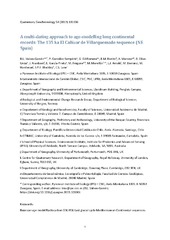| dc.contributor.author | Valero-Garcés, Blas L. | |
| dc.contributor.author | González-Sampériz, Penélope | |
| dc.contributor.author | Gil-Romera, Graciela | |
| dc.contributor.author | Benito De Pando, Blas Manuel | |
| dc.contributor.author | Moreno, Ana | |
| dc.contributor.author | Oliva-Urcia, Belén | |
| dc.contributor.author | Aranbarri, Josu | |
| dc.contributor.author | García-Prieto, Eduardo | |
| dc.contributor.author | Frugone, Matías | |
| dc.contributor.author | Morellón, Mario | |
| dc.contributor.author | Arnold, Lee J. | |
| dc.contributor.author | Demuro, Martina | |
| dc.contributor.author | Hardiman, Mark J. | |
| dc.contributor.author | Blockley, Simon P.E. | |
| dc.contributor.author | Lane, Christine S. | |
| dc.date.accessioned | 2020-04-28T10:33:41Z | |
| dc.date.available | 2020-04-28T10:33:41Z | |
| dc.date.issued | 2019 | |
| dc.Published | Valero-Garcés, González-Sampériz, Gil-Romera G, Benito De Pando BM, Moreno A, Oliva-Urcia, Aranbarri, García-Prieto, Frugone, Morellón, Arnold LJ, Demuro, Hardiman, Blockley SP, Lane CS. A multi-dating approach to age-modelling long continental records: The 135 ka El Cañizar de Villarquemado sequence (NE Spain). Quaternary Geochronology. 2019;54: 101006 | eng |
| dc.identifier.issn | 1871-1014 | en_US |
| dc.identifier.issn | 1878-0350 | en_US |
| dc.identifier.uri | http://hdl.handle.net/1956/22038 | |
| dc.description.abstract | We present a multidisciplinary dating approach - including radiocarbon, Uranium/Thorium series (U/Th), paleomagnetism, single-grain optically stimulated luminescence (OSL), polymineral fine-grain infrared stimulated luminescence (IRSL) and tephrochronology - used for the development of an age model for the Cañizar de Villarquemado sequence (VIL) for the last ca. 135 ka. We describe the protocols used for each technique and discuss the positive and negative results, as well as their implications for interpreting the VIL sequence and for dating similar terrestrial records. In spite of the negative results of some techniques, particularly due to the absence of adequate sample material or insufficient analytical precision, the multi-technique strategy employed here is essential to maximize the chances of obtaining robust age models in terrestrial sequences. The final Bayesian age model for VIL sequence includes 16 AMS 14C ages, 9 single-grain quartz OSL ages and 5 previously published polymineral fine-grain IRSL ages, and the accuracy and resolution of the model are improved by incorporating information related to changes in accumulation rate, as revealed by detailed sedimentological analyses. The main paleohydrological and vegetation changes in the sequence are coherent with global Marine Isotope Stage (MIS) 6 to 1 transitions since the penultimate Termination, although some regional idiosyncrasies are evident, such as higher moisture variability than expected, an abrupt inception of the last glacial cycle and a resilient response of vegetation in Mediterranean continental Iberia in both Terminations. | en_US |
| dc.language.iso | eng | eng |
| dc.publisher | Elsevier | en_US |
| dc.title | A multi-dating approach to age-modelling long continental records: The 135 ka El Cañizar de Villarquemado sequence (NE Spain) | en_US |
| dc.type | Peer reviewed | |
| dc.type | Journal article | |
| dc.date.updated | 2020-01-23T10:37:29Z | |
| dc.description.version | acceptedVersion | en_US |
| dc.rights.holder | Crown Copyright 2019 Published by Elsevier B.V. All rights reserved. | en_US |
| dc.source.articlenumber | 101006 | |
| dc.identifier.doi | https://doi.org/10.1016/j.quageo.2019.101006 | |
| dc.identifier.cristin | 1723882 | |
| dc.source.journal | Quaternary Geochronology | |
| dc.relation.project | Norges forskningsråd: 249894 | |
| dc.identifier.citation | Quaternary Geochronology. 2019;54: 101006 | |
| dc.source.volume | 54 | |
